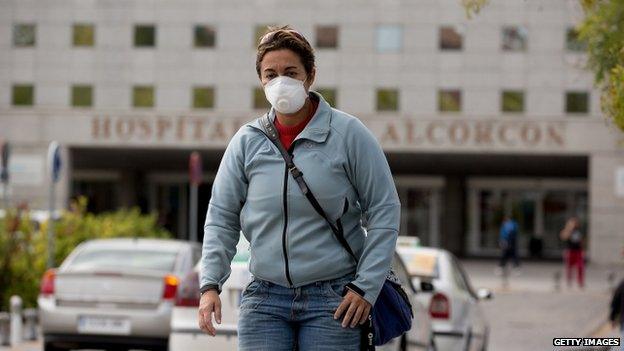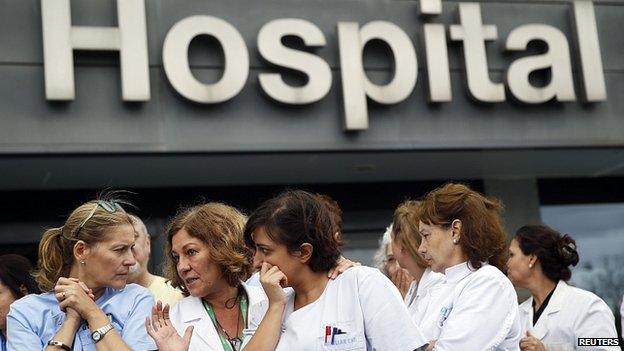Spain Ebola nurse: Relatives and hospital staff monitored
- Published
The hospital was reported to have had extreme protective measures in place as Hugh Pym reports
Doctors in Madrid have been testing three people for Ebola after a Spanish nurse became the first person known to have contracted the deadly virus outside West Africa.
Some 52 others are being monitored, health officials say.
The nurse, identified in media reports as Teresa Romero, had treated two Spanish missionaries who died of Ebola after being repatriated.
Some 3,400 people have died in the current outbreak.
Most of the deaths have been in Guinea, Sierra Leone and Liberia.
The International Monetary Fund (IMF) has warned of the dire consequences for the economies in the region if the virus continues to spread.
Meanwhile the chairman of the World Health Organisation's Ebola science group says he is not surprised that the Spanish nurse contracted the disease.
Speaking in Geneva, Prof Peter Piot said he expected more cases among medical staff, even in developed countries, and that the slightest mistake during the care of Ebola patients could be fatal.
Cleared
Reports said one of three people hospitalised in Madrid after the nurse's diagnosis tested negative for the virus on Tuesday.
A female health worker, who also treated one of the Spanish priests, has been cleared in two separate tests, health sources say.
The husband of the afflicted nurse and a Spanish man who travelled to Spain from Nigeria remain in quarantine.
The European Commission has asked Spain to explain how Ms Romero, a 40-year-old auxiliary nurse, could have become infected. A hospital investigation is under way.
She was one of about 30 staff at the Carlos III hospital in Madrid who had been treating priests Manuel Garcia Viejo and Miguel Pajares, officials say.

Manuel Garcia Viejo was the second Spanish priest to be repatriated from Africa with Ebola

A woman wears protective mask as she leaves Alcorcon hospital
Mr Garcia Viejo, 69, died at the hospital on 25 September after catching Ebola in Sierra Leone. Mr Pajares, 75, died in August after contracting the virus in Liberia.
Ms Romero had twice gone into the room where Mr Garcia Viejo had been treated, to be directly involved in his care and to disinfect the room after his death.
Madrid healthcare director Antonia Alemany said: "The nurse went into the room wearing the individual protection gear and there's no knowledge of an accidental exposure to risk."
Shortly afterwards she went on holiday but fell ill on 30 September and was admitted to Alcorcon hospital in south-west Madrid.
It was not clear where she went on holiday.
Prof Ildefonso Hernandez-Aguado, Spanish Association of Public Health: Ebola case down to 'procedure problem'
Early on Tuesday Ms Romero was moved under police escort to Carlos III hospital in the capital and is said to be in a stable condition.
The Spanish health authorities say she is being treated with a drip using antibodies from previous Ebola patients.
Doctors are monitoring 22 people including relatives and staff who had contact with the nurse at Alcorcon hospital, as well as 30 people working at Carlos III hospital.
All have been contacted by the health authorities.

Ebola virus disease (EVD)
Symptoms include high fever, bleeding and central nervous system damage
Spread by body fluids, such as blood and saliva
Fatality rate can reach 90% - but current outbreak has mortality rate of about 70%
Incubation period is two to 21 days
There is no proven vaccine or cure
Supportive care such as rehydrating patients who have diarrhoea and vomiting can help recovery
Fruit bats, a delicacy for some West Africans, are considered to be virus's natural host

The Carlos III hospital was reported to have had extreme protective measures in place including two sets of overalls, gloves and goggles.
However, health workers told El Pais newspaper that the clothing did not have level-four biological security, which is fully waterproof and with independent breathing apparatus.
Instead it was level two, the paper says, as photographs provided by staff indicated that the overalls did not allow for ventilation and the gloves were made of latex and bound with adhesive tape.
Health staff in Madrid protested over alleged safety failures on Tuesday.

Staff staged a protest outside La Paz Hospital in Madrid over the government's handling of the Ebola cases

Containing Ebola: BBC health correspondent Michelle Roberts
Patients should be isolated - ideally in a hospital with the highest level of bio-safety.
Such a facility would use a specially designed tent with controlled ventilation to house the patient's bed - this allows staff to provide clinical care while containing the infection.
Staff treating the patient must wear protective suits, gloves, masks and goggles. This equipment should be completely impermeable since Ebola is spread in bodily fluids such as sweat, urine and blood
Any clinical waste such as syringes, paper towels or clothing from the patient should be incinerated. A dedicated laboratory should be used to carry out any necessary tests.

IMF official Rupa Duttagupta said on Tuesday that a generally positive outlook for growth in sub-Saharan Africa was overshadowed by what she described as "the heavy economic toll" on countries worst affected by Ebola.
In other developments:
British health authorities have said there are no plans to introduce Ebola screening for travellers arriving in the UK
A container of aid materials for the fight against Ebola is at the centre of a political row, external in Sierra Leone
A Norwegian medic who tested positive for Ebola while working with Medecins Sans Frontieres in Sierra Leone has been flown back to Oslo
Shares in airlines including Easyjet and British Airways owner IAG have fallen sharply following the news of the Ebola case in Madrid
Ebola spreads through contact with bodily fluids and the only way to stop an outbreak is to isolate those who are infected.
There have been nearly 7,500 confirmed infections worldwide, with officials saying the figure is likely to be much higher in reality.
Guinea, Sierra Leone and Liberia have been hardest hit.
Thomas Duncan, the first person to be diagnosed with Ebola in the US, is being treated at a Dallas hospital. He caught the virus in his native Liberia. Doctors say he is in a critical but stable condition.
-
Protective Ebola suit
× -
Surgical cap
×The cap forms part of a protective hood covering the head and neck. It offers medical workers an added layer of protection, ensuring that they cannot touch any part of their face whilst in the treatment centre.
-
Goggles
×Goggles, or eye visors, are used to provide cover to the eyes, protecting them from splashes. The goggles are sprayed with an anti-fogging solution before being worn. On October 21, the US Centers for Disease Control and Prevention (CDC) announced stringent new guidelines for healthcare personnel who may be dealing with Ebola patients. In the new guidelines, health workers are advised to use a single use disposable full face shield as goggles may not provide complete skin coverage.
-
Medical mask
×Covers the mouth to protect from sprays of blood or body fluids from patients. When wearing a respirator, the medical worker must tear this outer mask to allow the respirator through.
-
Respirator
×A respirator is worn to protect the wearer from a patient's coughs. According to guidelines from the medical charity Medecins Sans Frontieres (MSF), the respirator should be put on second, right after donning the overalls.
-
Medical Scrubs
×A surgical scrub suit, durable hospital clothing that absorbs liquid and is easily cleaned, is worn as a baselayer underneath the overalls. It is normally tucked into rubber boots to ensure no skin is exposed.
-
Overalls
×The overalls are placed on top of the scrubs. These suits are similar to hazardous material (hazmat) suits worn in toxic environments. The team member supervising the process should check that the equipment is not damaged.
-
Double gloves
×A minimum two sets of gloves are required, covering the suit cuff. When putting on the gloves, care must be taken to ensure that no skin is exposed and that they are worn in such a way that any fluid on the sleeve will run off the suit and glove. Medical workers must change gloves between patients, performing thorough hand hygiene before donning a new pair. Heavy duty gloves are used whenever workers need to handle infectious waste.
-
Apron
×A waterproof apron is placed on top of the overalls as a final layer of protective clothing.
-
Boots
×Ebola health workers typically wear rubber boots, with the scrubs tucked into the footwear. If boots are unavailable, workers must wear closed, puncture and fluid-resistant shoes.
Are you affected by the issues raised in this story? You can email your experiences to haveyoursay@bbc.co.uk